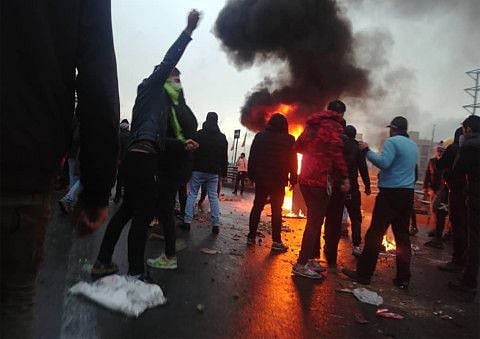Iran’s leaders cannot deflect public anger any longer
US will see the huge protests as proof that sanctions campaign against Iran are working

The full extent of the protests that erupted across Iran over the weekend is hard to gauge, not least because the regime in Tehran has shut down internet access for most of the country. That decision suggests that the regime feels more threatened by the latest demonstrations of public anger than it did by previous protests at the end of 2017.
This round was sparked by the government’s decision to raise gasoline prices, to plug a budgetary hole caused in part by US sanctions. But as we’ve seen recently in Lebanon and Iraq, the mood in the streets quickly morphed from complaints about gas prices to anger at general economic hardship and then to an anger at Iran’s system of government.
Despite the internet shutdown, videos circulated of protesters chanting slogans calling for the ouster of Supreme Leader Ali Khamenei. In some cities, they burned his posters — a brave thing to do in a theocracy that treats dissent with maximum cruelty.
Khamenei has had a bad few weeks: His name and image have been attacked in Baghdad and Beirut, as well as in his own country. He has backed the gas-price hike, with the careful caveat that he is not an expert in such matters. Characteristically, he has blamed “thugs” and foreigners for the protests and ordered a crackdown on Iranians voicing their unhappiness in the streets.
No surprise there: Khamenei fingered “enemies of Iran” for the 2017 protests; in reality, they were the result of rising food prices amid a general economic downturn. Then, too, he unleashed his security forces on the protesters.
Will the protests continue despite the crackdown? Again, the internet blackout makes it hard to know. Iranians will have noted the stamina shown by Iraqis and Lebanese, who have kept up their demonstrations for weeks on end. But the Iran is much more brutal than Iraq or Lebanon, and Khamenei seems determined to prevent any repeat of the 2009 Green Movement, which rattled the regimeBobby Ghosh
President Hassan Rouhani, on the other hand, is unlikely to repeat the softer line he took on the 2017 protests, when he allowed that Iranians were right to protest. This time, since the demonstrations are the direct consequence of his decision, Rouhani is unlikely to be so charitable.
Will the protests continue despite the crackdown? Again, the internet blackout makes it hard to know. Iranians will have noted the stamina shown by Iraqis and Lebanese, who have kept up their demonstrations for weeks on end. But the Iran is much more brutal than Iraq or Lebanon, and Khamenei seems determined to prevent any repeat of the 2009 Green Movement, which rattled the regime.
The Trump administration will see the protests as proof that the sanctions campaign against Iran is working. Secretary of State Mike Pompeo professed solidarity with the protesters, tweeting, “The US is with you.” This is unlikely to reassure any Iranians who recall President Trump’s promise in early 2018 that they would receive “great support” from the US. It is hard to argue with the regime’s assertion that such pronouncements are “hypocritical.”
But they needn’t be. The administration can clear away the sanctions-related uncertainties over the trade of essential and live-saving drugs to Iran.
Life-saving drugs and medical equipment are, technically, exempt from US sanctions. But confusion over what is and isn’t allowed and difficulty with processing payments have stymied Iranian importers. The Trump administration can easily solve these problems.
Doing these things now, while the protests are raging, would make it harder for Iran’s leaders to deflect public anger by blaming the usual suspect. Small gestures, perhaps. But keeping Iran’s protesters focused on the true source of their torments can only be a good thing.
— Bloomberg
Bobby Ghosh is a columnist who writes on foreign affairs. He is focused on the Middle East and the wider Islamic world.
Unlawful killings
Verified video footage, eyewitness testimony from people on the ground and information gathered from human rights activists outside Iran reveal a harrowing pattern of unlawful killings by Iranian security forces, which have used excessive and lethal force to crush largely peaceful protests in more than 100 cities across Iran sparked by a hike in fuel prices on November 15.
Source: Amnesty International
Also Read: Here is why Iranians are out in the streets
Also Read: Is US’s ‘maximum pressure’ on Iran working?
Sign up for the Daily Briefing
Get the latest news and updates straight to your inbox


